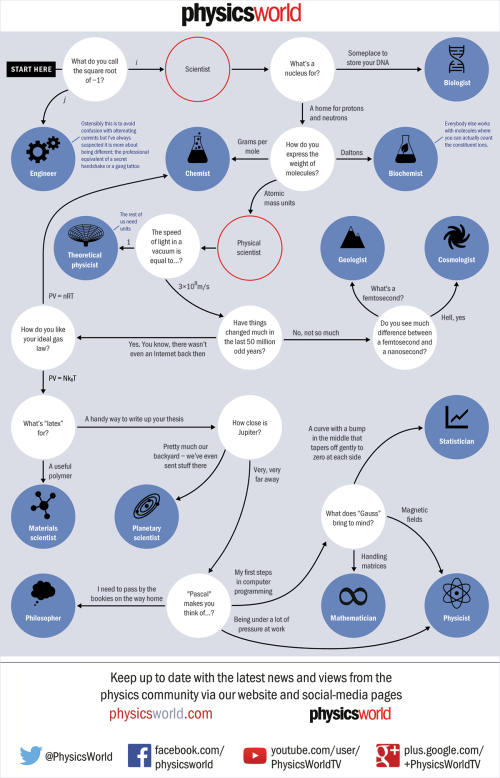By Margaret Harris
What kind of scientist are you? In a world where astronomers are getting into (exo)biology, geologists file their programming manuals next to their rock hammers and three physicists shared a chemistry Nobel prize for work with medical implications, it can be hard to keep track. But fear not. For behold, in the midst of this glorious interdisciplinary muddle (and, for many readers, the holiday season), we bring you tidings of great clarity. As it turns out, your scientific identity crisis can be solved with a simple flowchart.
The idea for the flowchart came last summer, when physicist Eugene Hickey submitted his ideas on sorting the geoscientists from the cosmologists to Lateral Thoughts, Physics World’s column of humorous and otherwise off-beat essays about physics and physicists. Hickey began his essay by observing that in his university (the Institute of Technology, Tallaght, near Dublin, Ireland) the interdisciplinary spirit has even trickled down to undergraduate level. For example, to create a materials-science degree, “the right physicist met up with the right chemist [and] decided to bolt together the best elements of both disciplines into a coherent bundle”. Students taking this degree, he added, “spent half their time in each department, like some sort of joint custody arrangement”.
Here in the Physics World offices, we rather liked the idea of chemists and physicists putting aside their differences to nurture fledgling materials scientists (although Hickey’s phrasing does imply there was a divorce at some point, we trust it was an amicable one). But the real fun began in the essay’s next paragraph, which suggested “putting together a test, a questionnaire, to let you figure out exactly who you are… Ideally, this would take the form of a flowchart with layers of questions helping you zero in on a specific identity. So if you are unsure whether you are a computational botanist, you think you might be a geochemical engineer, or if you have a hunch that you might well be a nano-molecular physicist, you could use this flowchart to find out in which pigeon hole(s) you may place your technical abilities”.
This sounded like a terrific idea, so we asked Hickey to reorganize his thoughts into a more flowchart-friendly format. Later, we also brought in Paul Matson, a designer in the IOP Publishing design studio, to give Hickey’s sketch a bit of artistic pizazz. See below for the result.
If your own discipline isn’t included in the flowchart, or if you feel the answer does not accurately reflect your true scientific nature, you won’t be alone. (Personally, the ideal gas law question classed me as a “chemist”; my excellent high school chemistry class must have made a deeper impression than my mediocre university course in thermodynamics.) But as Hickey concluded in his original essay, “Further suggestions will be most gratefully received. After all, as we’ve seen, there are a great many different disciplines out there, each with its own specific characteristics and quirks.”
If you’re feeling inspired, why not write your own Lateral Thoughts essay? Submissions to the Lateral Thoughts column must be 900–950 words long and may be e-mailed to pwld@iop.org.

Persons in different disciplines for historical reasons use different units that can be reduced and simplified to some “basic units” for everybody showing their multidisciplinary nature and reach.
If you think Neon is a metal then you’re an astrophysicist.
The flowchart is hilarious! Mr.’s Hickey and Matson should send it to the writers of Big Bang Theory – they would have a lot of fun with it…
It classified me as chemist as well .I had fun and flowchart is hilarious.